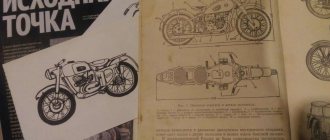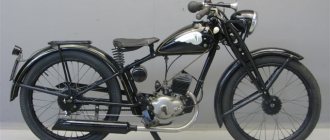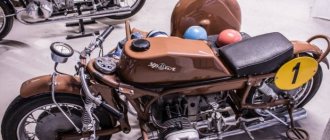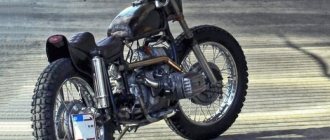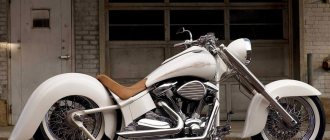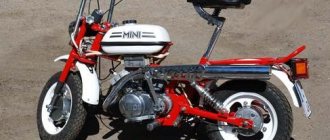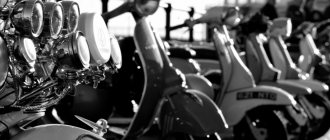It is believed that the first military motorcycles were created in 1898 by Frederick Sims. The car was equipped with four wheels, a bicycle-type frame, a saddle, and a 1.5 horsepower power unit. Motor Scout, and this is the name the vehicle received, was equipped as a weapon with a Maxim machine gun and an armored shield to protect the upper torso of the driver-gunner. The device was able to transport almost 0.5 tons of equipment, ammunition and other cargo. One refueling was enough for about 120 miles of travel. This version did not receive serious distribution in the army.
Development of military motor industry
By the beginning of the First World War, military motorcycles had become firmly established in army units and were used by all progressive states. The machines were intended to replace horses, so soldier couriers were the first to use the machines in question.
The first operational copies appeared in German army units. Unlike the “ancestor”, they were modernized civilian counterparts, reinforced with machine guns. Such mobile points, despite the thin armor, were successfully used in various operations on the fronts of the First World War.
Cushman Model 53.
Read more about this scooter here.
The simple and compact design of this scooter was conceived in order to parachute it into the areas of landing operations by the US Army.
During World War II, almost 5,000 copies were produced.
The weak engine, producing only 4.6 horsepower, however, was not powerful enough for any needs other than military shows and exhibitions.
There is a legend that the first Cushman was assembled by one of the employees of a military airfield simply from unnecessary spare parts from aircraft and mechanisms serving the airfield. It is worth noting that, even at that time, the Cushman had a rather fancy design (which the military probably liked) and, as a result, a very considerable weight for a scooter, 115 kg.
Post-war revitalization
In 1928, the French military motorcycle Mercier was presented. The front track wheel added originality to this creation. After 10 years, engineer Leêtre created a modernized analogue of this machine, called Tractorcycle, fully equipped with caterpillar tracks.
It was assumed that excellent maneuverability and light armor should provide the model with recognition and success in the military sphere. However, the bike had a number of significant disadvantages:
- Large mass (over 400 kg).
- Low speed setting (up to 30 km/h).
- Poor handling.
- Unstable roads.
Despite the fact that the designers soon added side wheels to the design, the army was never interested in this development.
Type 97
Built in 1937, the Type 97 was a Japanese imitation of American Harley-Davidsons. The motorcycle was used primarily on the Japanese islands, but was occasionally seen overseas as Japanese forces attempted to take over East Asia.
Soldiers pushing a motorcycle across the river
The Type 97 was sometimes used simply as a regular motorcycle, and sometimes fitted with a lightweight sidecar. It was usually not equipped with any weapons, although a machine gun was sometimes mounted on the sidecar.
Other original models
The original model of a military motorcycle was developed in Italy. Guzzi presented a tricycle with a machine gun and an armored shield. A feature of this modification was the “dead” placement of the machine gun, directed backwards.
Belgian designers also tried to create something unique in this regard. In 1935, FN presented a simplified model of the M-86. Compared to other European analogues of that time, the car received a number of advantages:
- Forced engine with a volume of 600 cc.
- Reinforced frame.
- Armored front and side sheets.
- Possibility of transporting an armored stroller with a Browning machine gun.
During serial production, over 100 similar copies were produced, operated by the armies of Romania, Brazil, China and Venezuela.
German military motorcycles
The leader of the German automotive industry, BMW, at first did not introduce any special innovations, mounting the M2-15B boxer engine onto existing vehicles. The first completely new production modification from German engineers was introduced in 1924.
Already in the early 30s, the Bavarian concern began updating the specialized military motorcycle BMW-R35. The model received a telescopic front fork, a reinforced power unit with 400 “cubes”, and a cardan transmission, which has a higher reliability indicator than the chain version. Among the shortcomings are the sins expressed in the rigid rear suspension and the fragility of the frame under load. However, the vehicle was used in motorized units, police, and medical battalions. The production of the device continued until 1940.
Simultaneously with the R35 version, the R12 modification was produced. In fact, this car was an improved version of the R32 series. The equipment was equipped with a 745-horsepower engine, a telescopic fork with hydraulic shock absorbers. In the design of the variation under consideration, one carburetor was removed, which reduced the power of the R-12 to 18 “horses”. This modification gained popularity due to its good parameters and low price, becoming the most widespread representative of its class in the German army. From 1924 to 1935, over 36 thousand copies were produced, both single and with a sidecar.
Of all the manufacturers of German military motorcycles, BMW's main competitor was Zundapp, which focused on government orders. Production models: K500, K600 and K800. The last version with a cradle was especially popular and was equipped with four cylinders. This feature, along with all the advantages, had its drawback in the form of frequent oiling of the candles, since not all components were heated evenly.
Military motorcycles of the USSR
After the end of the First World War, Russia practically did not have its own motorcycle production in the military sector. This situation lasted until the 30s of the last century. The technical equipment of the army required modernization, and therefore the development of the first domestic motorcycle, capable of withstanding all the hardships of the Russian climate, began.
The first army versions were the KhMZ-350 and L-300 modifications. The first device became an almost exact copy of the Harley Davidson, significantly inferior in quality to its American counterpart. Subsequently, it was decided to abandon it. It was replaced by the TIZ-AM600 version, produced since 1931. Its own development included British and American features, but did not show any special achievements.
In 1938, the Soviet design bureau presented several military models: L-8, as well as two IZhs, under the indices 8 and 9. As for the first copy, it was produced at various factories in the country, which made their own modifications, which led to the loss of unification of spare parts.
Kawasaki/Hayes M1030.
The Kawasaki KLR650 is probably the most utilitarian motorcycle ever built, and American firm Hayes Diversified Technologies redesigned it specifically for the US Army. This motorcycle is usually labeled "diesel", but in fact, it is multi-fuel, and can also be ridden on kerosene and a number of grades of aviation fuel used by the US Army. Before the 650cc version, the US Army also used Kawasaki KLR250 motorcycles.
World War II period
The first and only ones of their kind were two German military motorcycles with a sidecar: the BMW R75 and the Zundapp KS750. They were specially designed with off-road travel in mind. Wheel drives and special speeds equipped specifically for this purpose allowed these machines to be recommended exclusively on the positive side.
Due to the high price, the models in question were first supplied to parachute units and the Afrika Korps, and later to the SS troops. In 1942, a decision was made to produce an improved Zundapp KS-750 with a BMW 286/1 sidecar (a military motorcycle stored in a strategic reserve). It never went into production. Production was planned for the period after the order for 40 thousand copies of the R-75 and KS-750 was completed, of which only 17,000 were produced.
BMW R71
German designers decided to work on their own standard for military motor vehicles. So the BMW R71, which in the future was modified to the R75, was designed and assembled very competently for military needs.
It’s interesting that ChangJang and Dnepr are considered by fans to be reliable copies of the BMW R71, but this can be said with a stretch if we remember the quality standard that German concerns have set.
Kettenkrad
From 1940 to 1945 this half-track modification was used to transport light guns, acting as a tractor. The equipment was powered by a 1.5-liter Opel engine. In total, just over 8.7 thousand copies were produced, primarily aimed at the Eastern Front.
The tracks coped well with domestic off-road conditions. Among the disadvantages is a high percentage of rollovers on sharp turns, while the landing system made it difficult for the driver to quickly leave it. In addition, it was impossible to move on elevated places in a diagonal direction on this transport.
M-72
Russian military motorcycles of that period began to be created on the basis of BMW. Heavy equipment with a sidecar has been used in the USSR since 1945. The car was produced in five cities across the country. Until 1960. It was this modification that became the prototype for the future analogue under the Ural brand.
Initially, the devices under consideration were focused strictly on the needs of the army. The base was equipped with a mount for mounting powerful small arms. The bike has rightfully become the most popular fighting “iron horse”. His image is even on one of the postage stamps. In total, more than 8.5 thousand copies of this equipment were produced. Only in the mid-50s did the Ural military motorcycle go on sale to the public from conservation.
Vespa150 TAP
These combat scooters were created in France for their army. Mass production of this type of equipment began in 1956 and was equipped with a powerful 75 mm cannon. Such weapons did not contribute to the widespread use of the bike in the ranks of the armed forces. At the same time, the engine with a modest displacement of 145 cubic meters could not provide the required speed and mobility. The scooter reached a modest speed of up to 65 km/h. It is worth noting that the developers planned to use another similar analogue in pairs to transport shells.
ATGM in a sidecar and airborne Vespas
Even before the war, they tried to install Kurchevsky’s dynamo-rocket guns on motorcycles. However, they tried to equip all the equipment of the Red Army with these recoilless guns - from T-26 tanks to airplanes.
Motor cannon
They wanted to add such motorized guns to the strategic cavalry and even assembled 22 combat vehicles. But later the Bazaarleys were declared unsuitable for off-road driving. But the 76-mm guns themselves did not show any advantages over conventional anti-tank guns.
New attempts to arm motor vehicles continued after the end of World War II.
Troops usually land on enemy territory in isolation from ground forces. Therefore, the paratroopers needed their own artillery and means of combating enemy armored vehicles, which they really didn’t want to carry around on their backs.
Here the French distinguished themselves by coming up with an ingenious solution. They apparently envied the British paratroopers of World War II, who were supplied with bikes for special operations. Welbike weighed only 32 kilograms and was placed in a container dropped by parachute. On such a scooter, a paratrooper could travel 150 kilometers at one gas station at a speed of up to 50 kilometers per hour.
Unboxing the British Special Operations Bike
But the French designers decided to give the paratroopers transport with weapons. The 75-mm American M20 recoilless rifle was built into the Italian iconic Vespa scooter. The two-wheeled vehicle carried six shells, and even a trailer with various useful junk. Another scooter was carrying additional shells. The resulting motorized self-propelled gun was called Vespa 150 TAP.
In the second half of the 50s, about 800 of these Hornets were produced” (Italian Vespa). They managed to fight in Algeria and Indochina. But the gun turned out to be too heavy for the base, and motorized self-propelled guns were more often used as transport for communications delegates (after removing the guns).
The Chinese followed the same path and also made a motorcycle with recoilless operation. But the gun was original - their 82-mm cannon had a revolver reload.
Chinese motorcycle with a revolver"
In the USSR, they also constantly thought about how not only to drop anti-tank guns to paratroopers, but also to give the guns mobility. A walk-behind tractor with an engine from an M-72 motorcycle and a drive wheel from a truck were installed on one of the frames of the 85-mm D-44 divisional gun. The result was a self-propelled SD-44 cannon. More than 700 of these monsters were built for the Airborne Forces in the 50s.”
SD-44 is being loaded onto a military transport aircraft
A purely anti-tank gun SD-57 of 57 mm caliber was produced in a small series.
SD-57 and crew
The glorious traditions were continued by the airborne anti-tank gun Sprut-SD with an engine from LuAZ. Now the self-propelled gun for the Airborne Forces with the same name is armed with this weapon.
125-mm Sprut-SD cannon"
In the USSR they also followed simpler paths. Army motorcycles were equipped with mounts for ATGMs. They could easily equip “Urals” mobilized from the population in case of war. Such motor vehicles, along with Suaziks, were registered separately at the military registration and enlistment offices.
The idea of an anti-tank Urals was returned to in the 90s. The IMZ-8 motorcycle was equipped with a PK machine gun, a large-caliber Kord, ATGM-Fagot or Konkurs machine gun. A batch of such motorcycles was even purchased for Russian peacekeepers in Kosovo.
Since then, plant representatives have regularly offered military modifications of new models. In 2016, two-wheeled vehicles were even tested by the Airborne Forces. The Kalashnikov Concern announced the development of a bike with similar capabilities last year.”
Motorcycles have gone through more than a century of combat and are not yet thinking of leaving the theater of war. But their position as reconnaissance vehicles is being squeezed by ATVs, buggies and light armored vehicles. After all, although the motorcycle is fast, it is too vulnerable to fire. In the age of MRAPs that weigh down infantry fighting vehicles, an abundance of automatic small arms and cannons, motorized infantry will suffer too many losses without achieving any visible results. And combat bikers will remain in the ranks of various partisans and militants. But it's still beautiful to say the least.
K-750
The Dnepr military motorcycle of this series was an improved version of the M-72 and was produced in Kyiv since 1958. The car was equipped with an “engine” with a capacity of 750 “cubes”, like other analogues of this series from other manufacturers.
Features and Specifications:
- Motor power – 26 liters. With.
- Improved comfort and reliability.
- The chassis is made with hydraulic shock absorbers.
- The stroller was equipped with rubber springs and a special suspension.
- The increased cross-country ability of the K-750 military motorcycle was ensured by an improved drive mechanism for the cradle wheel.
- With an increase in engine power, fuel consumption decreased by almost one liter.
Welbike.
A separate large section of the book is devoted to British Welbikes, which in their design were an analogue of Cushman. The lightweight folding scooter was intended for special operations; it was dropped at the landing site in a special capsule, and then could be used to travel from the landing site to the site of the actual military operation.
New at the end of the last century
To enhance the motorized rifle capabilities of the army, in the mid-90s, a military motorcycle “Ural” of the IMZ-8.107 series was developed with a side wheel drive for the sidecar, providing increased maneuverability of the vehicle. The main purpose of the vehicle is to operate as part of patrol and mobile reconnaissance groups, for transporting communication systems and as a multi-purpose vehicle.
Smaller dimensions and increased maneuverability, compared to any army vehicle, make it an optimal means for conducting combat operations in urban conditions. The crew consists of two or three people, the weight of additional equipment ranges from 25 to 100 kg.
The main weapon is a 12.7 mm heavy machine gun. It makes it possible to hit low-flying air targets and ground targets with light armor. In addition, the weapons allow combat with enemy personnel at a distance of up to two thousand meters. Visibility makes it possible to fire from the personal weapons of the crew, which is under the cover of individual armor protection.
M1 Extra Light Solo Motorcycle
M1 Extra Light Solo Motorcycle
The American M1 weighed half as much as the WLA Harley-Davidson, and this was not surprising, since the motorcycle was originally intended for airborne paratroopers. To this end, its components were also designed to withstand falls, and the bike's ignition could be turned on even with a dead battery. Since the motorcycle turned out to be durable, reliable and comfortable for riding over rough terrain, after the war it was used not only by the military.
Features of "Ural"
The high dynamics of the military motorcycle, the photo of which is shown above, cross-country ability and maneuverability are ensured by a powerful engine, transmission and chassis. The bike has a base shortened to 1.5 meters, large 19-inch wheels with an all-terrain tread pattern.
The design and layout of the working elements is made according to the automotive principle:
- Motor lubrication system.
- The checkpoint is in a separate block.
- Cardan transmission shaft.
These features guarantee a high level of reliability and maintainability. The working life is increased by observing the use of suitable automotive-type motor and transmission oils.
The Ural combat motorcycle with a trailer has a particularly important parameter for performing combat missions - the ability to overcome obstacles that are beyond the capabilities of most vehicles. With the wheelchair raised, the equipment can move along one track while maintaining balance. This allows you to bypass deep holes and obstacles up to 70 centimeters high. The weight of the motorcycle is 315 kilograms, which makes it possible for the crew to turn the unit over a fallen tree or barrier structure. Speeds of up to 100 km/h provide a high margin of time for maneuvering, while operation of the bike in question is possible in various climatic zones (from – 40 to + 50 degrees).
Characteristics of IMZ-8.107
Below are the main performance characteristics of the Ural military motorcycle:
- Engine type: naturally aspirated four-stroke gasoline engine.
- Power indicator – 23.5 kW.
- Wheel formula – 3*2.
- Gearbox – 4 modes with reverse gear.
- The frame is a welded tubular type.
- Front/rear suspension - levers/pendulums with spring hydraulic shock absorbers.
- The voltage in the on-board network is 2 V.
- Maximum travel speed is 105 km/h.
- The range on one fill is 240 km.
- Length/width/height – 2.56/1.7/1.1 m.
- Dry weight – 315 kg.
- Possibility of using weapons - 12.7 or 7.6 mm machine gun, ATGM, AGS, RPG.
- Additional equipment – fuel container, searchlight, set of entrenching tools.
Harley-Davidson
Also popular in recent years is the Harley Davidson army motorcycle with a 350cc two-stroke single-cylinder Rotax engine. This modification is common in various countries of the world and is used as a vehicle for reconnaissance or escort. Among the disadvantages of this model is the use of J-8 fuel, which in composition is more reminiscent of a mixture of diesel fuel and aviation kerosene. This makes it unsuitable for use on gasoline engines. There are exceptions, such as the HDT M103M1 model. The average speed of the device is 55 miles per hour.
"Sunrise"
Voskhod motorcycles began to be produced in the city of Kovrov, in the Vladimir region, in 1957. These were very unpretentious single-cylinder motorcycles (173.7 cm3 engine). The Dyagterev plant constantly improved this model, releasing onto the market, following the Voskhod, its modernized versions, such as Voskhod-2, Voskhod-3, Voskhod-3M. The latest Voskhod motorcycle was the 3M-01 model with a 15 hp engine. Because of their reliability, Voskhod motorcycles became real workers in thousands of Soviet villages. To this day, you can easily find a Voskhod motorcycle in good condition there.
